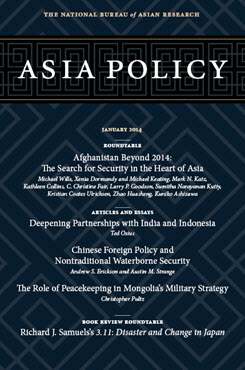Iran and Afghanistan
The Urgent Need for Inclusive Regional Diplomacy
This is one of nine essays in the roundtable “Afghanistan Beyond 2014: The Search for Security in the Heart of Asia.”
Iran wants a stable Afghanistan and has meticulously worked to protect its interests before and after 2001 to this end. Prior to 2001, Iran was the primary backer of the anti-Taliban Northern Alliance, and after September 2011 it was one of the earliest supporters of the U.S.-led invasion of Afghanistan to rout the Taliban. Since then, the country has established considerable political and economic presence in its eastern neighbor—both overt and covert—through generous cash payments to the Afghan government and essential development aid delivered through religious and charitable organizations. Tehran also seeks long-term political stability in Afghanistan, though it is no stickler for liberal democracy. In the short term, Iran appears to be fairly satisfied with the status quo as long as Afghanistan is not used as a base for attacks against it.
Tehran would like its vision for a stable Afghanistan to be realized within a context of zero U.S. troops on the ground after 2014. Consequently, it is keeping a very close eye on developments in the country, specifically the withdrawal of the International Security Assistance Force (ISAF). This essay examines Iran’s enduring interests in Afghanistan and their implications for relations with the United States and other regional players beyond 2014.
Iran’s Interests in Afghanistan
Afghanistan has always been strategically significant to Iran. The landlocked country shares a 582-mile border with Iran to its west, and the two neighbors have no unsettled territorial disputes, which is a rarity in the region. They also share linguistic, cultural, and religious links—one-fifth of Afghanistan’s population is Shia—owing to their common history under consecutive Persian empires.
Iran has four long-standing strategic objectives vis-à-vis Afghanistan. First, Tehran wants an administration in Kabul that will not only distance itself from the United States but also remain wary of the Taliban and its state sponsors, Pakistan and Saudi Arabia. Such being the case today, Iran will continue its policy of supporting the Afghan presidency. It will not object to the 2014 elections producing a Pashtun majority as long as ethnic minorities, such as the Tajiks and Hazaras, obtain fair representation in the new government. Iran has previously demonstrated such tolerance in the Bonn conference of 2001 and in the 2004 and 2009 elections. This willingness ties into Iran’s second non-negotiable interest: leveraging the Shiite Dari/Persian-speaking non-Pashtun population. The country has protected the interests of its traditional Afghan allies—the Farsiwan Heratis, the Shia Hazara, and Tajiks—and cultivated relations with as many factions as possible, including those supporting the incumbent president Hamid Karzai. Iran has also built and maintained close ties with key players in the Afghan political landscape, including Abdullah Abdullah, presidential candidate and leading opposition figure; Ismail Khan, vice presidential candidate and former governor of Herat; and Mohammad Yunus Qanooni, the lower house speaker and political and military heir of Ahmad Shah Massoud. This political clout will help Tehran advance its goals in Afghanistan after 2014. In addition, Iran has preserved relationships with the militias it helped train during the Soviet invasion.
Iran’s third priority is safeguarding on-the-ground investments and personnel, particularly in western Afghanistan. The killings of Iranian diplomats in Mazar-e-Sharif in 1998 serve as a stark reminder of the threats that Iranians engaged in commerce can face from a resurgent Taliban. Such personnel are at the forefront of Iran’s strategic vision of playing a powerful role in Afghanistan beyond the political and security realms. Preserving an economic sphere of influence in Afghanistan is Iran’s fourth strategic objective. The country pledged a total of $900 million in aid for reconstruction projects during 2002–13, with about $500 million disbursed at the time of writing. [1] Iran accounts for roughly 35%–40% of exports to Afghanistan, and annual bilateral trade stands at around $2 billion. [2] In terms of private investment, an estimated two thousand private Iranian firms operate in Afghanistan. [3]
[1] See Lydia Poole, “Afghanistan: Tracking Major Resource Flows 2002–2010,” Global Humanitarian Assistance, Briefing Paper, January 2011, 4, http://www.globalhumanitarianassistance.org/wp-content/uploads/2011/02/gha-Afghanistan-2011-major-resource-flows.pdf; and Kenneth Katzman, “Afghanistan: Post-Taliban Governance, Security, and U.S. Policy,” Congressional Research Service, CRS Report for Congress, RL30588, October 23, 2013, 51, http://www.fas.org/sgp/crs/row/RL30588.pdf.
[2] F. Milad, “Official: Tehran-Kabul Trade to Hit $3 Billion,” Trend News Agency, September 8, 2012, http://en.trend.az/regions/iran/2063182.html.
[3] Hazifullah Gardesh, “Afghans Fear Fallout from Iran Sanctions,” Institute for War and Peace Reporting, Afghan Recovery Report, October 3, 2006, http://iwpr.net/report-news/afghans-fear-fallout-iran-sanctions.
About Asia Policy
Asia Policy is a peer-reviewed scholarly journal presenting policy-relevant academic research on the Asia-Pacific that draws clear and concise conclusions useful to today’s policymakers. Asia Policy is published quarterly in January, April, July, and October and accepts submissions on a rolling basis. Learn more


